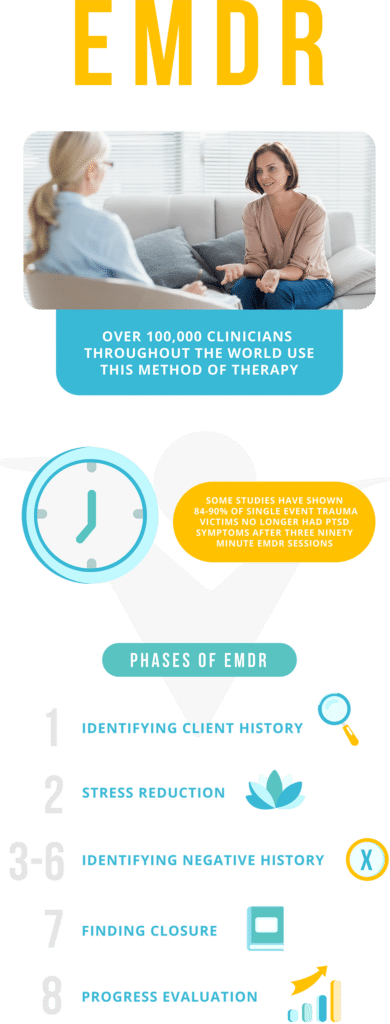What is EMDR Therapy?
In Eye Movement Desensitization and Reprocessing therapy, healthcare professionals stimulate rapid rhythmic eye movements in their patients, similar to those that occur during REM sleep. This process helps decrease the intense negative feelings that occur due to post-traumatic stress disorder (PTSD) and/or previous trauma.
To perform EMDR therapy, health care professionals ask their patients to recall the memories that are causing them PTSD and/or feelings of trauma while simultaneously making them move their eyes in a way that stimulates rapid rhythmic eye movements. Usually, therapists will do this by moving a pen or finger in front of their patients’ faces while making their patients follow the movements of the object with their eyes.
Does This Therapy Approach Really Work?
Eye movement desensitization and reprocessing therapy does, in fact, work! The reason for this is, as studies have shown, diverting your attention from your traumatic memories through rapid eye movements will decrease the negative emotions caused by those memories. EMDR helps you to reprocess how your brain stores those traumatic memories.
EMDR is a non-traditional form of psychotherapy created by psychologist Francine Shapiro in 1989. Shapiro created this type of therapy after realizing that the intensity of her negative emotions while thinking about certain subjects decreased whenever she darted her eyes back and forth.
Soon after coming to this realization within herself, Shapiro started testing this theory on her patients. After doing so, she realized that her patients also experienced decreased negative emotions from their traumatic and/or negative thoughts and memories when simultaneously darting their eyes around.
Now that you understand the background behind EMDR therapy, discover the ways in which it can help treat addiction!
How Healthcare Providers Can Use EMDR Therapy to Help Those Suffering from Addiction
As previously stated, EMDR therapy is primarily associated with treating those who suffer from PTSD or past traumas. Post-traumatic stress disorder is a well-known root cause of addiction. Many drug and alcohol users use these substances as a way to cope with the uncomfortable and negative effects of trauma.
Due to the realization of how mental health disorders connect with drug and alcohol addiction, addiction treatment facilities are making more of an effort to offer holistic care. Rehab facilities are striving to provide treatment plans that help heal the bodies and minds of recovering individuals. Thus, more and more addiction treatment facilities are incorporating this therapeautic approach into their usual treatment plans.
This approach to therapy is beneficial to drug and alcohol addicts because of the fact that this form of therapy does not require patients to take any medications. This is particularly beneficial to individuals who have just gone through detox and are at a higher risk of relapse. EMDR therapy can also be good for those who struggle with triggering memories of substance use or even “addiction memory”.
What is Addiction Memory?
Addiction memory occurs when someone has specific hard-wired euphoric or traumatic memories associated with their addiction. These memories may overwhelm the individual’s normal memory channels. People who suffer from addiction memory often have such intense and sporadic replay of their euphoric or traumatic addiction moments that it haunts them.
Sometimes these euphoric or traumatic memories are associated with an outside traumatic moment that caused the addicts to seek out drugs and/or alcohol. Other times they are associated with memories of physical injury. The latter is particularly true for opioid users. This is because many of them started using opioids as a way to cope with pain from a physical injury.
Phases of EMDR Therapy
To help recovering individuals living with PTSD, past trauma, and/or addiction memory, it is important that EMDR therapy is done in the proper phases. There are eight phases.
Phase 1 – Identifying Client History
In the first phase of EMDR therapy, the therapist will identify client history. They try to find any history of emotional distress or childhood trauma. They also look for any other significant traumatic memories that could be a contributing factor to the patient’s PTSD.
Phase 2 – Stress-Reduction Techniques
In the second phase of EMDR therapy, therapists will teach the clients/patients some stress-relieving techniques. These techniques and methods work to help people better cope with their PTSD and/or trauma.
During this phase, the therapist will also review how well the individual is utilizing the skills taught to them during the periods of time between therapy sessions.
Phases 3 – 6 – Identifying Targeted Traumatic Events and Negative Beliefs
During phases 3 through 6 of this type of therapy, patients work to identify traumatic events that may have led to PTSD. During these phases, the patients must also identify any negative feelings they have about themselves.
Then, individuals will also need to identify the positive feelings that they have for themselves. They’ll need to perform mental exercises with these positive feelings to help relieve their overall stress.
Phase 7 – Closure
Within the 7th phase of EMDR therapy, the patients must keep a log of their positive and negative feelings and memories as they arise. Individuals in therapy must also continue to practice their new stress-relieving techniques to relieve any stress that they experience.
Phase 8 – Progress Examination
In the 8th phase of EMDR therapy, the patients and therapists will work to examine and assess everything that they have done together thus far. They will then record how much progress they made in the area of coping with stress throughout their therapy sessions.
Pros and Cons of EMDR Therapy
Since EMDR therapy is a newer, non-traditional form of psychotherapy, many people still question its validity. Many people also question whether or not this therapy method is worth their time and investment. To help you decide whether EMDR therapy is right for you, we are going to go over the pros and cons of it with you.
Pros of EMDR Therapy
- It requires no medication.
- This method helps treat the core of addiction.
- It requires little time commitment.
- EMDR therapy is relatively inexpensive.
- Medical insurance covers this therapy approach.
- It can strengthen the effectiveness of your medications.
- It will ultimately improve your overall mental health.
- EMDR therapy teaches you credible basic coping principles.
- It can be done in the privacy of your own home.
Cons of EMDR Therapy
- Rapid eye movement exercises may be uncomfortable to do.
- Recalling traumatic memories can be emotionally painful and exhausting.
- There is not much research behind it.
- It can cause side effects such as light-headedness and vivid dreams.
- Although it is not too time-consuming in the grand scheme of things, it will require you to follow through with all its phases.
Ultimately, you should not make a decision about addiction treatment and therapy without the help of a professional. A substance abuse therapist can give you the guidance and advice you need in order to begin and work through recovery.
The Credibility of EMDR Therapy
Again, EMDR therapy is a non-traditional form of psychotherapy so there is not as much research on it as you might find with other types of therapy. Right now, however, there are certainly theories about why and how EMDR therapy is effective.
In any case, though, EMDR therapy uses many of the same basic principles that healthcare professionals stand by in their prolonged exposure therapy. In fact, many of the principles of EMDR therapy are even in the gold standard behavioral psychotherapeutic treatment of PTSD.
If the credible basic principles that EMDR therapy stands on is not enough evidence for you of its credibility, then perhaps the fact that numerous credible medical guidelines have defined the people that will benefit from EMDR therapy will.
For example, the American Psychiatric Association (APA) states that EMDR therapy is effective for treating both acute and chronic PTSD. The APA also states that this therapy method is effective for people who have trouble speaking about traumatic events that they have experienced.
Both the Department of Veterans Affairs and the Department of Defense strongly advise the use of EMDR therapy for the PTSD of military men and women and their loved ones. The Department of Veterans Affairs and the Department of Defense even go as far as to state that, according to their studies, EMDR therapy has been just as effective as any other psychological treatment when it came to the PTSD of military men and women.
Learn More Today!
To learn more about EMDR therapy and our drug and alcohol addiction recovery programs, contact us here at Free by the Sea. Our compassionate staff members are waiting to take your call. Here at our facility, we are committed to your success and we look forward to providing you with the help and hope you need as you pursue recovery!

Dr. Richard Crabbe joined our team in 2019 as our psychiatrist and medical director. He attended the University of Ghana Medical School where he became a Medical Doctor in 1977. From 1978 through 1984, he was a medical officer in the Ghana Navy and provided a variety of services from general medicine to surgeries. He received his Certificate in General Psychology from the American Board of Psychology and Neurology in 2002.



